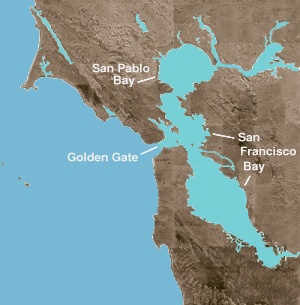
The San Francisco Estuary together with the Sacramento–San Joaquin River Delta represents a highly altered ecosystem. The region has been heavily re-engineered to accommodate the needs of water delivery, shipping, agriculture, and most recently, suburban development. These needs have wrought direct changes in the movement of water and the nature of the landscape, and indirect changes from the introduction of non-native species. New species have altered the architecture of the food web as surely as levees have altered the landscape of islands and channels that form the complex system known as the Delta.[1]
This article deals particularly with the ecology of the low salinity zone (LSZ) of the estuary. Reconstructing a historic food web for the LSZ is difficult for a number of reasons. First, there is no clear record of the species that historically have occupied the estuary. Second, the San Francisco Estuary and Delta have been in geologic and hydrologic transition for most of their 10,000 year history, and so describing the "natural" condition of the estuary is much like "hitting a moving target".[1] Climate change, hydrologic engineering, shifting water needs, and newly introduced species will continue to alter the food web configuration of the estuary. This model provides a snapshot of the current state, with notes about recent changes or species introductions that have altered the configuration of the food web. Understanding the dynamics of the current food web may prove useful for restoration efforts to improve the functioning and species diversity of the estuary.